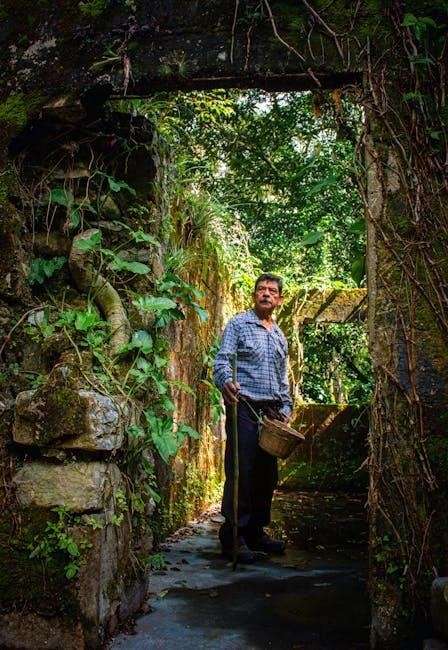Village life offers a nurturing environment for families, emphasizing community support, safety, and a strong sense of belonging, making it ideal for raising children in a natural setting.
Understanding the Structure of Village Communities
Village communities are tightly knit, often organized around a central hub like a village square or local school. These communities are typically hierarchical, with elders or elected leaders making decisions. Families often live in close proximity, fostering strong social bonds and mutual support. Local traditions, festivals, and cultural practices play a significant role in shaping village life. Punjab, for instance, exemplifies this with its vibrant festivals and communal celebrations. While villages vary in size and resources, they share a common emphasis on collective well-being. Challenges like limited amenities and infrastructure are often mitigated through teamwork and shared responsibility, creating a resilient and interconnected way of life.
Benefits of Raising Children in a Village Environment
Raising children in a village environment provides a unique set of advantages. Villages offer a safe, close-knit atmosphere where kids can thrive under the watchful eyes of the community. The natural surroundings and open spaces encourage outdoor activities, fostering physical and mental well-being. Children often develop strong social skills through interactions with diverse age groups, enhancing their emotional intelligence. Additionally, villages expose kids to practical life lessons, such as farming or local crafts, which build resilience and a connection to their roots. The slower pace of life and emphasis on tradition also help instill values like respect and responsibility, creating a balanced upbringing that combines modern influences with timeless wisdom.

Parenting in a Village
Parenting in a village offers a unique blend of community support, safety, and a close-knit environment, fostering a holistic upbringing for children surrounded by nature and tradition.
Unique Challenges Faced by Village Parents
Village parents often face challenges like limited access to education, healthcare, and extracurricular activities for their children. Isolation from urban amenities can hinder personal and professional growth. Balancing traditional values with modern influences while ensuring children adapt to global trends is another difficulty. Safety concerns in remote areas, such as limited surveillance and exposure to natural risks, add to parental worries. Additionally, reliance on community support can sometimes lead to privacy issues. Despite these challenges, many village parents find creative solutions, leveraging local resources and fostering strong family bonds to provide a nurturing environment for their children to thrive.
Parenting Tips for Raising Children in a Rural Setting
- Foster a strong sense of community by encouraging participation in local events and traditions.
- Teach children to appreciate and respect nature through outdoor activities and environmental education.
- Encourage independence and self-reliance by involving kids in household and farming tasks.
- Provide access to educational resources and support to bridge the gap with urban opportunities.
- Promote safety awareness, such as understanding risks in remote areas and emergency preparedness.
- Model values like honesty, kindness, and hard work to help children develop strong moral foundations.
These strategies help parents nurture resilient, well-rounded children in a rural environment.
The Role of Technology in Modern Village Parenting
Technology plays a vital role in modern village parenting, offering tools to enhance education, safety, and communication. Online learning platforms like Google Classroom provide access to quality resources, bridging the urban-rural gap. Parents can monitor their children’s progress remotely and engage with teachers digitally. Safety apps enable real-time tracking, ensuring children’s security in vast rural areas. Additionally, technology fosters community connections through social media groups and local forums, helping parents share advice and resources. However, balancing screen time with outdoor activities remains crucial to maintaining the unique charm of village life while embracing modern conveniences.

Safety and Privacy in the Village
Village life offers a close-knit community with strong safety networks, but privacy concerns arise due to everyone knowing each other’s affairs, requiring mindful balancing by parents.
A Parents Guide to Safety in Rural Areas

Rural areas offer a peaceful environment, but parents must remain vigilant about potential dangers. Children should be taught to avoid interacting with strangers and warned about wildlife or traffic hazards. Supervising kids during outdoor activities is crucial, especially near water bodies or farms. Parents should also educate their children on emergency procedures, such as dialing local helpline numbers. Ensuring visibility of children through reflective clothing or ID tags can enhance safety. Building a support network with neighbors and local authorities is essential for quick responses. Regularly discussing safety protocols and boundaries helps children understand risks and make informed decisions, fostering a secure village upbringing.
Privacy Concerns in Close-Knit Village Communities
In close-knit villages, privacy can be a challenge due to the strong sense of community and shared daily life. Neighbors often know each other’s affairs, which can sometimes lead to gossip or unintended breaches of personal information. Parents should teach children the importance of respecting others’ privacy while also protecting their own family’s boundaries. Establishing clear guidelines for sharing personal matters and encouraging open communication can help maintain trust. Additionally, parents can model behaviors that promote privacy, such as avoiding oversharing and respecting confidentiality. Balancing community involvement with personal privacy is key to fostering a harmonious village life for families.
Teaching Children About Safety and Boundaries
Teaching children about safety and boundaries is crucial in a village setting, where familiarity can sometimes lead to complacency. Parents should educate their kids on stranger danger, even in close-knit communities, and emphasize the importance of staying within designated safe zones. Encouraging open communication about their daily activities and ensuring they know trusted adults to approach in emergencies is vital. Setting clear boundaries, such as understanding when and where to play, helps children navigate village life safely. Involving the community in reinforcing these lessons can also create a collective sense of responsibility for their well-being. Balancing freedom with responsibility ensures children thrive in a secure environment.

Education in the Village
Village education emphasizes local schools’ pivotal role in fostering academic and practical skills, ensuring children thrive in a nurturing environment with access to enriching extracurricular activities.
Access to Quality Education in Rural Villages
Access to quality education in rural villages is a cornerstone for fostering development and opportunity. While challenges like limited resources and infrastructure persist, many villages emphasize local schools as hubs for learning. Dedicated teachers and community-driven initiatives often bridge gaps, ensuring children acquire essential skills. Extracurricular activities and practical training further enrich educational experiences, preparing students for future challenges. Despite constraints, the commitment to education in rural settings highlights the importance of equipping children with knowledge and values, fostering a brighter future for village communities.
Role of Local Schools in Village Communities
Local schools play a vital role in village communities, serving as hubs for education, socialization, and cultural preservation. They provide children with foundational knowledge, fostering intellectual growth and preparing them for future opportunities. Beyond academics, schools often host community events, reinforcing village traditions and unity. Teachers in rural areas frequently go above and beyond, addressing the unique needs of their students despite limited resources. These institutions also promote extracurricular activities, encouraging holistic development and teamwork. By nurturing young minds, local schools contribute to the overall progress and sustainability of village life, ensuring that future generations are equipped to thrive in an ever-changing world.

Extracurricular Activities for Village Children
Extracurricular activities in villages offer children diverse opportunities for growth beyond academics, fostering creativity, teamwork, and physical well-being. Programs like sports, art classes, and cultural workshops are common, allowing children to explore their passions. Many villages organize community events such as festivals and fairs, where kids can participate in performances, competitions, and traditional games. These activities not only build confidence but also strengthen bonds within the community. Additionally, outdoor adventures like camping and nature walks connect children with their surroundings, promoting environmental awareness. Such initiatives ensure village children receive a well-rounded education, preparing them for future challenges while preserving local heritage and values.

Community Involvement
Community involvement strengthens village life, fostering unity and support among residents. Parents can engage through volunteering, local events, and collaborative efforts, creating a caring environment for all families.
How Parents Can Engage with the Village Community
Parents can actively engage with their village community by participating in local events, volunteering at schools, and joining clubs or committees. Attending community meetings ensures their voices are heard. Sharing skills, such as teaching or organizing workshops, fosters connections. Supporting local businesses and initiatives strengthens the village economy. Encouraging children to join youth groups or sports teams promotes socialization. Online platforms can also be used to stay informed and contribute ideas. By collaborating with neighbors and local leaders, parents can help address community challenges, creating a safer, more supportive environment for everyone. This involvement not only benefits the village but also sets a positive example for children.
Volunteering and Its Impact on Village Life
Volunteering is a powerful way for parents to contribute to village life, fostering a sense of unity and responsibility. By helping at local schools, organizing community events, or supporting safety initiatives, parents can make a meaningful impact. Volunteering not only improves village services but also sets a positive example for children, teaching them the value of giving back. It strengthens community bonds and ensures that initiatives like festivals, education programs, and safety measures thrive. Through volunteering, parents can address local challenges while inspiring others to join in, creating a more vibrant and supportive environment for everyone. This collective effort enhances the quality of life for all villagers.
Building a Support Network for Parents
Creating a support network for parents in a village is essential for fostering collaboration and mutual assistance. By connecting through local groups or community initiatives, parents can share resources, advice, and experiences. This network helps address challenges like childcare, education, and safety while providing emotional support. Regular meetups or online forums can facilitate open communication and problem-solving. A strong support system ensures parents feel less isolated and more empowered to contribute to village life. It also encourages collective advocacy for better amenities and services, ultimately benefiting both families and the community as a whole. This shared effort strengthens the village’s social fabric and resilience.

Cultural and Heritage Activities
Villages preserve rich cultural heritage through vibrant festivals, traditions, and historical sites, offering families a unique opportunity to connect with their roots and pass it down to children.
Teaching Children About Village Traditions
Teaching children about village traditions fosters cultural pride and continuity. Share stories, participate in festivals, and involve them in local customs to help them understand their heritage. Encourage them to ask questions and explore historical sites within the village. This hands-on approach ensures traditions are passed down through generations, creating a sense of belonging and identity. By engaging in these activities, children develop respect for their roots and a deeper appreciation for community values. Make learning fun with interactive experiences, such as traditional music, dance, or crafts, to keep the village’s cultural legacy alive and vibrant for years to come.
Celebrating Festivals and Events in the Village
Celebrating festivals and events in the village is a vibrant way to connect with culture and community. Parents can engage children in local traditions, such as harvest festivals or religious celebrations, fostering a sense of belonging. These events often include music, dance, and food, creating memorable experiences for families. Participating in village fairs or cultural ceremonies teaches children about their heritage and strengthens community bonds. Encourage kids to join in activities like crafting, storytelling, or traditional games, which promote teamwork and cultural awareness. Such gatherings also provide opportunities for children to learn from elders, blending fun with education and fostering unity among villagers of all ages.
Exploring Local History and Heritage

Exploring local history and heritage is a enriching experience for children in a village setting. Parents can guide their kids to discover historical sites, such as ancient temples, monuments, or landmarks, which often hold stories of the village’s past. Visiting museums or attending heritage walks can deepen their understanding of local culture. Encourage children to engage with elderly villagers, who often share tales of traditions and historical events. This fosters a connection to their roots and helps them appreciate the legacy of their community. By exploring heritage, children gain a sense of identity and pride in their village’s unique history and traditions.
Raising children in a village offers a unique blend of community support, natural surroundings, and cultural richness, providing a holistic environment for their growth and development.
Final Thoughts on Parenting in a Village
Parenting in a village offers a unique opportunity to raise children in a close-knit, supportive community with strong cultural ties and a connection to nature. The slower pace of life allows for meaningful family bonding and a sense of belonging. While challenges like limited resources and modern amenities exist, the benefits of a nurturing environment, shared responsibilities, and a focus on traditional values often outweigh these difficulties. Parents can foster resilience and empathy in their children by encouraging community involvement and teaching the importance of heritage. With the right mindset and support, village life can be a rewarding and enriching experience for families.

Resources for Village Parents
Village parents can benefit from various resources to support their parenting journey. Online platforms like Google Classroom offer access to educational materials and remote learning tools. Local community centers often provide workshops on parenting techniques and child development. Safety guides and privacy settings resources help protect children in rural areas. Additionally, many villages have libraries and schools that serve as hubs for educational and extracurricular activities. Parenting groups and support networks within the community can provide emotional and practical assistance. Lastly, regional organizations may offer specific programs tailored to the needs of village families, ensuring they have the tools to thrive in a rural environment.